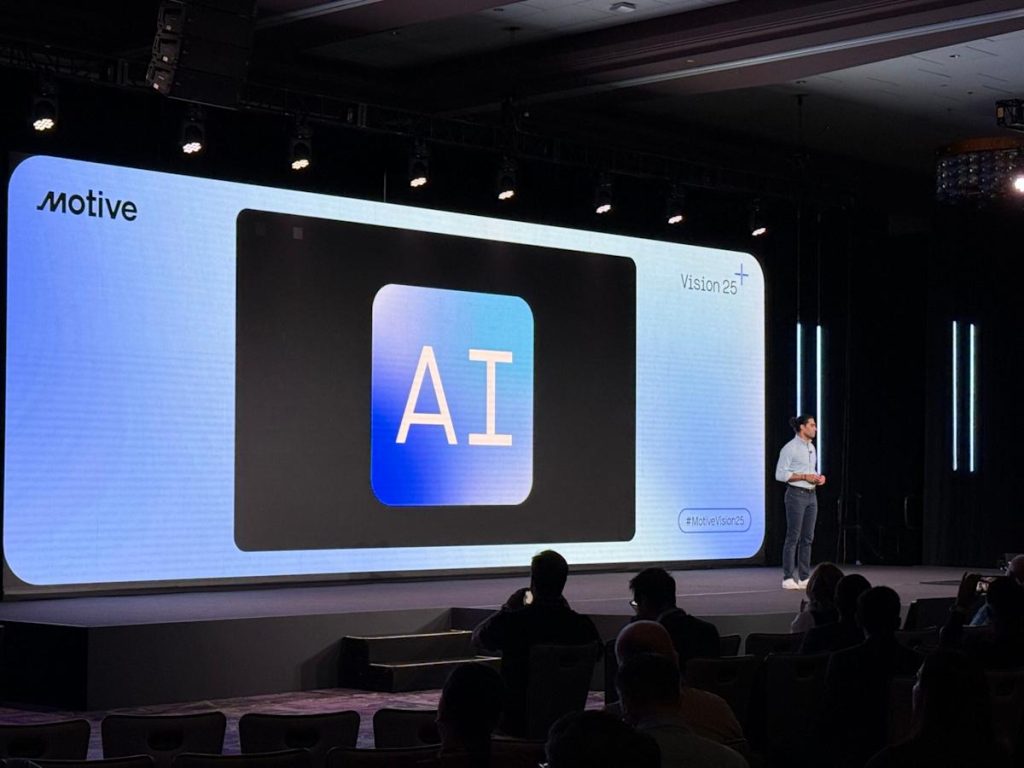AUSTIN, Texas – Technology and telematics company Motive announced at its Vision 25 user conference a host of new features expanding on its AI-powered, integrated operations platform. Some of the features include AI safety models to reduce collisions, an AI Assistant for time-sensitive issues and fraud detection including a $250,000 fraud protection guarantee.
This is part of a yearslong effort of AI research and development dating back to 2021, when early AI computer vision models were able to recognize instances of following too closely and cell phone usage. Fast forward to 2025 and the data collected over the years now allows Motive’s computer vision to recognize instances as unique as eating, smoking, pedestrian collisions and drowsiness – capabilities that are expanded upon with a new index.
The central themes were helping fleets across multiple metrics, with a heavy emphasis on tools to keep fleets compliant.
“Our mission is to empower the people who run physical operations with AI-powered tools that make their work safer, more productive and more profitable,” said Shoaib Makani, co-founder and CEO of Motive. “At Vision 25, we showed how Motive is using AI to break down silos between safety, operations and finance teams and replace manual workflows with intelligent automation.”
The audience consisted of companies from across the transportation and supply chain, from trucking, transportation and construction to fleet technology and analytics, that operate within the Motive ecosystem. Areas where Motive tech is used can vary from the urban core of San Francisco to the oil fields of Texas’ and New Mexico’s Permian Basin.
Using AI to combat driver fatigue
As part of the release, Motive announced an index that measures over 10 driver fatigue indicators, including yawning, eye rubbing, lack of movement and abnormal speed changes to alert drowsy driving before a crash occurs. During the keynote address, Makani and other executives highlighted how their earlier work in detecting drowsiness led to them locating clusters of behaviors that, combined, created conditions that made it highly likely an accident could occur.
Another AI model announced was a detection feature that flags repeated lane swerving over time. Swerving can often be a sign of fatigue or distraction. Executives noted that out of thousands of real-world driving scenarios, swerving paired with other indicators like yawning and eye rubbing can occur within minutes and be the precursor to an accident.
Addressing the truck parking shortage is a feature that detects unsafe parking. It is built to alert managers in real time once a vehicle is pulled over in a high-risk area. The computer vision can recognize if a vehicle is parked on the curb or side of a highway and is designed to help prevent “sitting duck” collisions in which a stationary vehicle is hit by another vehicle on the roadway.
For fleets looking to manage all these added features, Motive announced the release of an AI Assistant to help manage the complexity. During the presentation, the AI Assistant allowed customizable AI-generated messages to be sent to targeted drivers for things ranging from severe weather alerts to the sudden appearance of engine fault codes that may result in an imminent breakdown.
The company hopes to expand these capabilities later this year.
Fighting fraud with technology and a $250K guarantee
For Motive customers who use its fuel card originally released in 2022, the company now has added skin in the game in the form of a Fraud Protection Guarantee. The guarantee covers up to $250,000 in losses annually when customers enable its AI-powered fraud controls on the Motive card.
Part of the reason behind the guarantee stems from the company’s combining its in-house vehicle telematics data with the Motive Card Payment data, compared to traditional stand-alone card solutions. The company estimates that worldwide card fraud losses are projected to exceed $43 billion in the next year, with U.S. businesses alone expected to lose $12.5 billion in 2025. The company gave an estimate that a 500-vehicle fleet can lose over $250,000 from unauthorized transactions including card skimming, fuel theft and out-of-policy spend.
The keynote highlighted instances in which pairing telematics and card data was an advantage. That included one situation in which a card transaction took place but was located miles away from its assigned vehicle location. Another was when a driver attempted to use fuel cards at a stop where fuel was significantly higher-priced than in the surrounding area. The AI located alternative fueling locations, declined the transaction and recommended to the driver a route to reach a cheaper fueling station. For instances of card skimming, automated features like predetermined fuel thresholds or amounts are valuable tools when drivers attempt to fuel more than their needed amount and pocket the difference by fueling for someone else.
New integrated analytics dashboard to tie it all together
One standout feature announced was the launch of Motive Analytics to help operations, safety and finance teams create dashboards to view key performance indicators without needing prior coding skills. An AI-powered query and creation feature is slated to launch later this year using natural language processing to create real-time charts and graphs.
The keynote demonstration included an example in which a fleet was able to create a general map of total miles driven, then drill down into utilization by region and city and pull up individual driver utilization metrics all within one AI-powered query system.
This is part of a larger trend of telematics providers expanding offerings to workflow and workforce development, using AI to sort through reams of data that in previous years would be difficult to do except with dedicated business analysts.
The post Motive announces suite of new AI products appeared first on FreightWaves.

